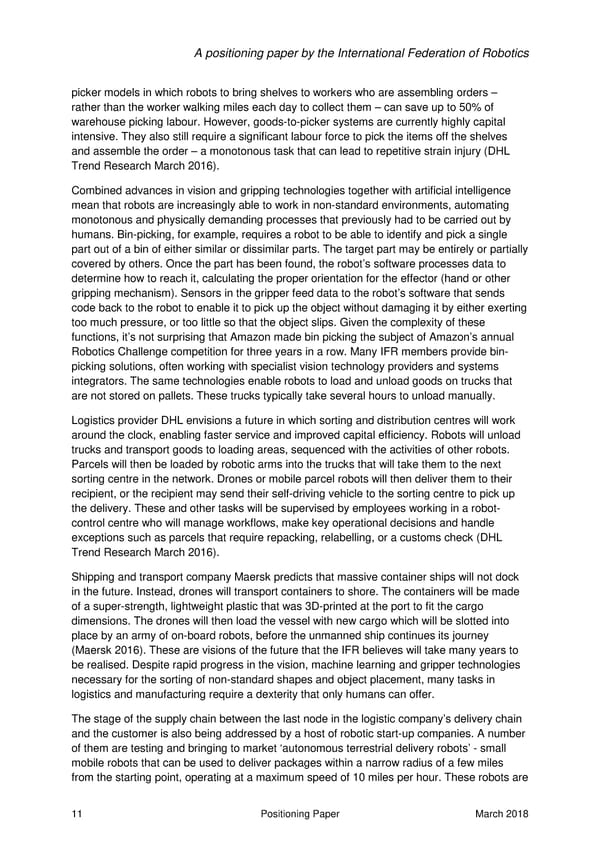A positioning paper by the International Federation of Robotics picker models in which robots to bring shelves to workers who are assembling orders – rather than the worker walking miles each day to collect them – can save up to 50% of warehouse picking labour. However, goods-to-picker systems are currently highly capital intensive. They also still require a significant labour force to pick the items off the shelves and assemble the order – a monotonous task that can lead to repetitive strain injury (DHL Trend Research March 2016). Combined advances in vision and gripping technologies together with artificial intelligence mean that robots are increasingly able to work in non-standard environments, automating monotonous and physically demanding processes that previously had to be carried out by humans. Bin-picking, for example, requires a robot to be able to identify and pick a single part out of a bin of either similar or dissimilar parts. The target part may be entirely or partially covered by others. Once the part has been found, the robot’s software processes data to determine how to reach it, calculating the proper orientation for the effector (hand or other gripping mechanism). Sensors in the gripper feed data to the robot’s software that sends code back to the robot to enable it to pick up the object without damaging it by either exerting too much pressure, or too little so that the object slips. Given the complexity of these functions, it’s not surprising that Amazon made bin picking the subject of Amazon’s annual Robotics Challenge competition for three years in a row. Many IFR members provide bin- picking solutions, often working with specialist vision technology providers and systems integrators. The same technologies enable robots to load and unload goods on trucks that are not stored on pallets. These trucks typically take several hours to unload manually. Logistics provider DHL envisions a future in which sorting and distribution centres will work around the clock, enabling faster service and improved capital efficiency. Robots will unload trucks and transport goods to loading areas, sequenced with the activities of other robots. Parcels will then be loaded by robotic arms into the trucks that will take them to the next sorting centre in the network. Drones or mobile parcel robots will then deliver them to their recipient, or the recipient may send their self-driving vehicle to the sorting centre to pick up the delivery. These and other tasks will be supervised by employees working in a robot- control centre who will manage workflows, make key operational decisions and handle exceptions such as parcels that require repacking, relabelling, or a customs check (DHL Trend Research March 2016). Shipping and transport company Maersk predicts that massive container ships will not dock in the future. Instead, drones will transport containers to shore. The containers will be made of a super-strength, lightweight plastic that was 3D-printed at the port to fit the cargo dimensions. The drones will then load the vessel with new cargo which will be slotted into place by an army of on-board robots, before the unmanned ship continues its journey (Maersk 2016). These are visions of the future that the IFR believes will take many years to be realised. Despite rapid progress in the vision, machine learning and gripper technologies necessary for the sorting of non-standard shapes and object placement, many tasks in logistics and manufacturing require a dexterity that only humans can offer. The stage of the supply chain between the last node in the logistic company’s delivery chain and the customer is also being addressed by a host of robotic start-up companies. A number of them are testing and bringing to market ‘autonomous terrestrial delivery robots’ - small mobile robots that can be used to deliver packages within a narrow radius of a few miles from the starting point, operating at a maximum speed of 10 miles per hour. These robots are 11 Positioning Paper March 2018
 Robots & the Workplace of the Future Page 11 Page 13
Robots & the Workplace of the Future Page 11 Page 13